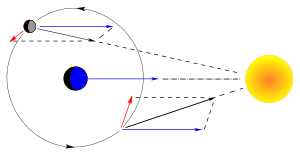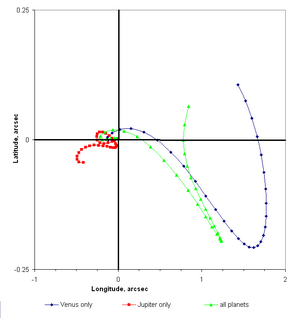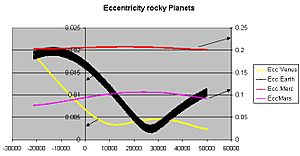Perturbation (astronomy) facts for kids
In astronomy, a perturbation is when a space object, like a planet or moon, moves in a way that isn't just because of the gravity of one other object. Other forces can also affect its path. These forces might come from other planets, or even from the object moving through a thin atmosphere. Sometimes, if a planet isn't perfectly round, its uneven shape can also pull on other objects in unexpected ways.
What are Orbital Perturbations?
Scientists started studying perturbations when they first tried to guess where planets would be in the sky. Long ago, people didn't know why planets moved in such complex ways. Isaac Newton, who discovered the laws of motion and gravity, was the first to study perturbations. He quickly saw how hard it would be to calculate these complex movements.
Many smart mathematicians since then have worked on these problems. In the 1700s and 1800s, it was very important to know the exact positions of the Moon and planets. This information helped sailors navigate their ships across the oceans.
The complicated movements caused by gravity can be broken down. Imagine an object moving around just one other object. Its path would be a simple shape, like a circle or an oval. This is called a two-body problem. It's like a perfect, undisturbed orbit. But when other forces are involved, the object's path changes. These changes are the perturbations.
If there's only one other important object pulling on it, it's a three-body problem. If there are many objects, it's called an n-body problem. We can easily figure out the path for a two-body problem using math. But for three or more bodies, it's much harder to predict their exact paths over time. Even a two-body problem gets tricky if one of the objects isn't perfectly round.
In most space systems, one main object has the strongest pull. For example, a star pulls on its planets, or a planet pulls on its satellites. The gravity from other, smaller objects can then be seen as small "nudges" or perturbations to this main orbit.
Why do Orbits Change Over Time?
In our Solar System, many of the changes in a planet's orbit are regular. They happen when one planet passes another in its path. This makes the objects follow paths that repeat or almost repeat. The Moon's orbit around Earth, for example, is strongly affected by the Sun's gravity. This repeating pattern helped scientists discover the planet Neptune in 1846. They noticed that Uranus wasn't moving exactly as expected, and realized another planet must be pulling on it.
Planets constantly pull on each other. This causes their orbits to slowly change over very long periods. These changes are most noticeable when two planets' orbital times are almost the same. For instance, Jupiter goes around the Sun about five times in the same time that Saturn goes around twice. This causes big changes for both planets over 918 years. This cycle was first noticed by Pierre-Simon Laplace.
Right now, Venus has the most circular orbit of all the planets. But in about 25,000 years, Earth's orbit will become even more circular than Venus's. Scientists have found that these long-term changes in the Solar System can become very unpredictable over millions of years. Sometimes, planets could even cross each other's paths, which might lead to collisions!
The paths of many smaller objects in the Solar System, like comets, are often greatly changed. This is especially true because of the strong gravity of the gas giant planets like Jupiter. While many of these changes are regular, some are not. These unpredictable changes can be a sign of chaotic motion. For example, in 1996, Jupiter's gravity caused Comet Hale–Bopp's orbit to shrink. Its travel time around the Sun went from 4,206 years down to 2,380 years. This change won't go back to normal in any regular way.
See also
- Formation and evolution of the Solar System
- Frozen orbit
- Molniya orbit
- Nereid
- Osculating orbit
- Orbit modeling
- Orbital resonance
- Proper orbital elements
- Stability of the Solar System




